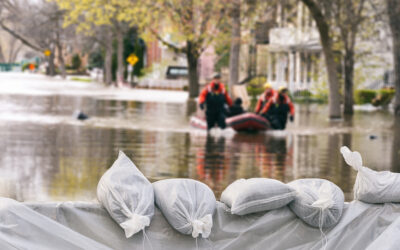Winter Storm Elliott made headlines in December 2022 for its incredible ferocity and destructive power. Amid the reports, many of us first encountered the term “bomb cyclone.” While not a rare phenomenon, bomb cyclones don’t usually cause the level of damage that Elliott inflicted.
Air travel during the 2022 holiday season produced moments many of us won’t soon forget. What started as routine flight delays at the end of December quickly spiraled into a dystopian nightmare of canceled flights, stranded travelers, and harried airline workers with a backdrop of mountains of lost luggage in airports coast to coast.
Down at ground level, Winter Storm Elliott pummeled the eastern United States in the form of a harrowing blizzard that produced record-setting snowfall, freezing temperatures, power outages, and at least 69 fatalities. New York Governor Kathy Hochul compared the devastation in her state to “a war zone.”
As residents and communities struggle to recover, the insurance claims are coming in. Claims Journal reported projections from modeling firm Karen Clark & Co. of $5.4 billion in insured losses in 42 states. The same article, along with many others, described the event as a “bomb cyclone.”
Catastrophic weather events are one of the biggest concerns in the insurance marketplace today, and bomb cyclone formation is sure to be a hot topic for carriers, brokers, and property owners in 2023. With that in mind, here is an overview of this weather phenomenon as described by The Weather Channel (read the full article here).
What is a Bomb Cyclone?
“Bomb cyclone” is a commonly used name to describe a low-pressure system occurring in the winter that explosively intensifies within a 24-hour period and typically includes heavy snow and strong winds. Specifically, it occurs when the central pressure of a low-pressure system drops at least 24 millibars within 24 hours.
How Did it Get That Name?
The term “bomb cyclone” is a derivation of the meteorological term “bombogenesis,” which is itself derived from “explosive cyclogenesis.”
Are Bomb Cyclones Common Events?
Primarily occurring from October through March, bomb cyclones are not uncommon along the East Coast of the United States. New England’s fabled nor’easters often qualify as bomb cyclones. However these storms can occur in every state as these recent events demonstrate:
- Less than two weeks after Winter Storm Elliott, in January 2023, a bomb cyclone pounded California with life-threatening rain, flooding, landslides, and power outages.
- Winter Storm Ulmer in March 2019 brought heavy snow, rain, and winds to the Central Great Plains.
- In March 2018, Winter Storm Riley caused destructive coastal flooding along the Eastern Seaboard.
What Happens When a Storm “Bombs Out”?
As a storm undergoes bombogenesis, it becomes more intense in multiple ways. Wind gusts accelerate to 50 mph or more, snowfall and other precipitation increases, and lightning frequently occurs. The resulting damage may include blizzard-level snowfall, downed trees and electrical poles, icy temperatures, and flooding.
Winter Storm Elliott was, thankfully, a rarity in comparison to most storms in this category in terms of its destructive wind gusts, snow, low temperatures, and ferocity. However, as with other natural disasters, bomb cyclones represent a potentially significant exposure in terms of property damage and liability claims. MiniCo’s programs offer coverage for a number of specialized property categories including Self-Storage, Nonprofit and Social Services, Artisan Contractors, Landscaping, Equipment Breakdown, and more. Contact our underwriters today to learn more.




